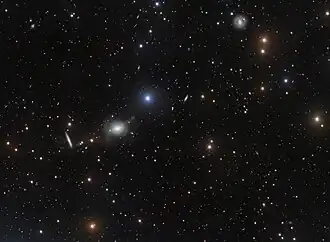NGC 5018
| NGC 5018 | |
|---|---|
 NGC 5018 taken by ESO's Very Large Telescope.[1] | |
| Observation data (J2000[2] epoch) | |
| Constellation | Virgo |
| Right ascension | 13h 13m 01.000s[2] |
| Declination | −19° 31′ 05.87″[2] |
| Redshift | 0.009413[2] |
| Heliocentric radial velocity | 2809km/s[2] |
| Distance | 132.51 Mly |
| Apparent magnitude (B) | 11.71[2] |
| Characteristics | |
| Type | S...[2] |
| Other designations | |
| 6dFGS gJ131301.0-193106, ESO 576-10, ESO-LV 576-0100, GSC 06116-01096, IRAS 13103-1915, IRAS F13103-1915, ISOSS J13130-1931, LEDA 45908, 2MASX J13130099-1931058, MCG-03-34-017, PSCz Q13103-1915, SGC 131020-1915.3, UGCA 335, [CHM2007] HDC 772 J131300.99-1931058, [CHM2007] LDC 955 J131300.99-1931058, [FWB89] Galaxy 337, [M98c] 131020.0-191518, [SLK2004] 800[2] | |
NGC 5018 is an elliptical galaxy located in the constellation of Virgo at an approximate distance of 132.51 Mly. NGC 5018 was discovered in 1788 by William Herschel.
Supernovae
Three supernovae have been observed in NGC 5018:
- SN 2002dj (Type Ia, mag. 17) was discovered by LOTOSS (Lick Observatory and Tenagra Observatory Supernova Searches) on 12 June 2002.[3][4]
- SN 2017isq (Type Ia, mag. 15.345) was discovered by ATLAS on 4 December 2017.[5]
- SN 2021fxy (Type Ia, mag. 16.9) was discovered by Kōichi Itagaki on 17 March 2021.[6]
See also
References
- ^ "Elliptical elegance". eso.org. Retrieved 2018-08-09.
- ^ a b c d e f g h "SIMBAD Astronomical Database - CDS (Strasbourg)". Results for NGC 5018. Retrieved 2018-08-09.
- ^ Hutchings, D.; Li, W. D. (2002). "Supernova 2002dj in NGC 5018". International Astronomical Union Circular (7918): 1. Bibcode:2002IAUC.7918....1H.
- ^ "SN 2002dj". Transient Name Server. IAU. Retrieved 4 August 2025.
- ^ "SN 2017isq". Transient Name Server. IAU. Retrieved 4 August 2025.
- ^ "SN 2021fxy". Transient Name Server. IAU. Retrieved 4 August 2025.
External links
 Media related to NGC 5018 at Wikimedia Commons
Media related to NGC 5018 at Wikimedia Commons